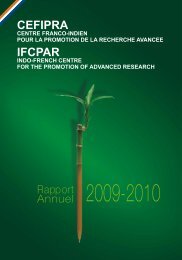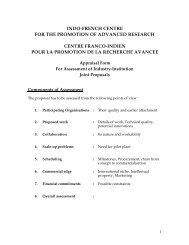IFCPAR AR (ENGLISH) for CD - CEFIPRA
IFCPAR AR (ENGLISH) for CD - CEFIPRA
IFCPAR AR (ENGLISH) for CD - CEFIPRA
You also want an ePaper? Increase the reach of your titles
YUMPU automatically turns print PDFs into web optimized ePapers that Google loves.
56<br />
Pure & Applied Chemistry<br />
Dr. G. V. M. Sharma<br />
Organic Chemistry Division III<br />
Indian Institute of Chemical Technology<br />
Hyderabad<br />
Prof. Christian Bruneau<br />
UMR 6226 CNRS<br />
Université de Rennes I<br />
Rennes<br />
Project 3805-2<br />
NON-NATURAL PEPTIDES IN ASYMMETRIC<br />
CATALYSIS: METAL-MEDIATED SYNTHESIS OF PEPTIDE-BASED<br />
MATERIALS AND THEIR APPLICATIONS<br />
<strong>IFCP<strong>AR</strong></strong><br />
Indo-French Centre <strong>for</strong> the Promotion of Advanced Research<br />
Duration: Three years (September, 2008 to August, 2011)<br />
Objectives<br />
The project aim was to synthesize new catalysts and use them to<br />
develop a variety of functionally diversified amino<br />
acids/peptides and new materials <strong>for</strong> asymmetric catalysis and<br />
<strong>for</strong> biomedical applications. The project was expected to lead<br />
to not only novel catalysts, non-natural amino acids, peptides<br />
but also nanoparticles biomaterials organic-inorganic hybrids,<br />
and the peptide-metal enantioselective catalysts.<br />
Accomplishments<br />
i) Preparation of various peptide substrates with unsaturated<br />
side chains was achieved. The RCM mediated cyclization of<br />
different peptides resulted in interesting results. The systems<br />
which would result in 11 and 13-membered rings,<br />
underwent facile cyclization, while, the systems that are<br />
expected to give 9-membered rings were found to be<br />
reluctant to RCM. Likewise, yet another interesting<br />
observation on the RCM of a different dipeptide was in the<br />
<strong>for</strong>mation of a selective head-to-tail double cross<br />
metathesis product from two units<br />
ii) The studies helped in deriving the factors that are governing<br />
the cyclisation and macrocyclization reactions. The results<br />
on the <strong>for</strong>mation of unexpected products during RCM<br />
helped in designing newer systems <strong>for</strong> further studies to<br />
prove the found observations<br />
iii) Six-membered ring ruthenium complexes featuring<br />
phosphino sulfonate moieties as β-amino<br />
acid surrogates<br />
were also prepared. Evaluation of these complexes led to<br />
the development of sustainable trans<strong>for</strong>mations such as<br />
allylation of indole derivatives with allylic alcohols with the<br />
generation of water as sole by product. More recently, first<br />
ruthenium-catalyzed C(3) functionalization of cyclic amines<br />
with aldehydes has been developed. Two new ruthenium 6membered<br />
ring complexes based on the Ru(p-cymene)<br />
core and -amino acid ligands have been prepared.<br />
Application of these complexes would lead to the<br />
development of enantioselective versions of the recent<br />
application. Other hydrogen transfer reactions will not be<br />
discarded considering the potential of such methodology<br />
Research papers published: Five





